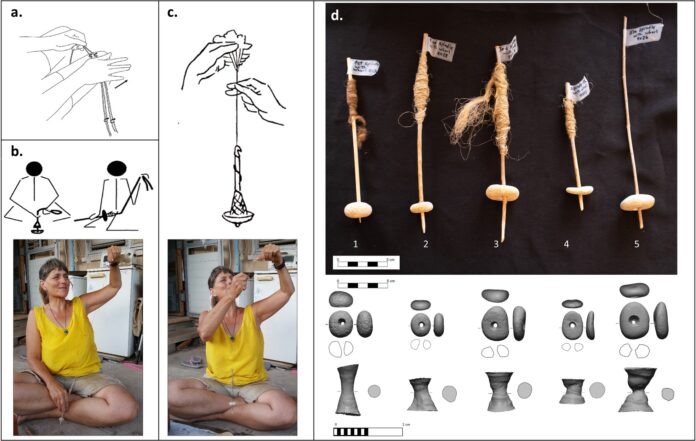
Spinning methods. (a) Manual thigh-spinning [64]; (b) Spindle-and-whorl “supported spinning” [68]; (c) “drop spinning” [66]; (d) the experimental spindles and whorls, the 3D scans of the pebbles and their negative perforations. The bottom pictures show Yonit Kristal experimenting spinning fibers with replicas of the perforated pebbles, using supported spinning and drop spinning techniques (photographed by Talia Yashuv). (Credit: Yashuv, Grosman, 2024, PLOS ONE)
Perforated pebbles discovered in Israel may roll back the time of the wheel invention by thousands of years, according to a study in PLOS ONE.
Archeologists had traced the origins of the wheel to around 3500 B.C. in Mesopotamia, where people used wheels to make pottery. About 300 years later, evidence of wheels used as transportation emerged. Many digs at burial sites dating back 4,000 years to 5,000 years unearthed wheeled carts. Archeologists have also discovered drawings and writings showing the wheel used as transportation for both people and products, dated a bit later.
Now, a collection of perforated pebbles found in the Nahal-Ein Gev II dig site in northern Israel, pushes the essential invention’s founding to about 12,000 years ago — essentially doubling the time of the wheel’s existence. But these small stone donut-shaped objects were almost certainly not used for transportation.
Re-imagining the Wheel
Due to their size and the presence of whorls, the pebbles were likely used as an early version of a spinning wheel to gather up fibers like wool or flax and transform it into yarn. The study’s authors Talia Yashuv and Leore Grosman, both from the Hebrew University of Jerusalem, tested that hypothesis by successfully spinning flax into yarn using replicas of the stones.
They first used digital 3-D models to examine the artifacts — all of which featured a circular shape perforated by a central hole. Due to this structure and composition, the authors of the new paper deduced that the stones were likely used as spindle whorls. Then they tested them.
“The most important aspect of the study is how modern technology allows us to delve deep into touching the fingerprints of the prehistoric craftsman, then learn something new about them and their innovativeness, and at the same time, about our modern technology and how we’re linked,” the authors said in a press release.
Read More: 5 Inventions That Changed The World
Wheels Throughout Time
It’s possible these stones paved the way for first, the potter’s wheel, then wheels for carts and chariots. The potter’s wheel represents one jump, because the axle holding it would have to be fixed to another object, while the Israeli examples were likely handheld. Attaching an axle to a load-bearing vehicle would require another jump in innovation.
These proto-spinning wheels likely played a key role in the transition to an agricultural lifestyle in the Neolithic period, and inspired the development of the cart wheels of the Bronze age.
Read More: Disturbing or Ingenious? These 5 Inventions Were Meant For Something Else
Article Sources
Our writers at Discovermagazine.com use peer-reviewed studies and high-quality sources for our articles, and our editors review for scientific accuracy and editorial standards. Review the sources used below for this article:
Before joining Discover Magazine, Paul spent over 20 years as a science journalist, specializing in U.S. life science policy and global scientific career issues. He began his career in newspapers, but switched to scientific magazines. His work has appeared in publications including Science News, Science, Nature, and Scientific American.
Source : Discovermagazine














